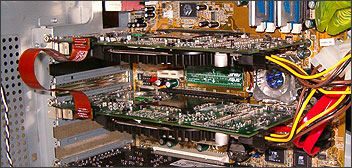6800 GT in SLI, power supplies and the cooling question
6800 GT is in many ways a much more attractive proposition than 6800 Ultra, in terms of an SLI configuration. One of those ways is performance, which I'll show you shortly. However, the overriding factors, at least for this reviewer, comes down to facets such as physical cost and availability (it's simply cheaper to use GTs, and they're more likely to be readily available), the heat generated (they're clocked lower and therefore generate less heat) and their power consumption (again, lower clocks means less of a power drain).While I showed in the first article that a pair of Ultras were sustainable using a high quality power supply, such as the Tagan in the SLI review systems I use, GTs are more attractive for those with similar high-quality supplies but with less sustainable output. The power supply is a major component in your PC system, and with SLI it definitely becomes a paramount consideration and I'd argue that it's the single most important part required for a stable SLI setup (disregarding issues with early revision mainboards, their bridge silicon and ribbon-style inter-GPU connectors).
Given that stable supply, your next consideration is the cooling in your case. While I wasn't able to measure with any real scientific consistency, my in-case temperature readings for dual-GTs have so far shown that they run on average, under load, up to 10°C cooler per card. And that contributes to a significantly lower ambient case temperature. With Ultras, you need to make sure your case cooling is really up to the job, the uppermost board getting very hot indeed under sustained periods of load. However I've found that with GTs, regular case cooling, and by that I mean just a couple of good 92 or 120mm fans, one at the front and one at the rear for exhaust, is plenty for removing the heat generated. There's more room between the cards, allowing for less restricted airflow and effective cooling.
Two large cards like 6800 GTs have the potential to affect what would otherwise be perfectly good cooling for a single board system, so be on your toes if you're creating an SLI system for yourself.
Here's a shot of the boards running in tandem on the ASUS A8N-E SLI mainboard I used for the Ultras (note the brown PCB, not black as in the final mainboard revision), so you can see the gap between the boards. That space is more than just an afterthought, it really plays a part in reliable, crash free SLI.
Click on the image to see a larger version and you can more clearly see the continuity connector that performs the slot remap, to run a pair of PEG16X slots in PEG8X mode, to the 16 lane PEG IO on the bridge.
The eagle-eyed among you will also see a green wire on each board, the boards having been modified for slightly more core voltage than standard on that PCB revision. Retail boards have the correct PCB revision.











